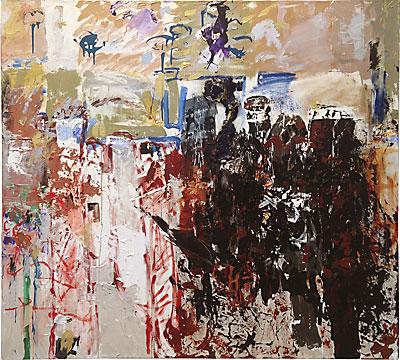Connie Fox on Sammy’s Beach

If you look up Sammy’s Beach on the Internet, you are given maps, a lot of real estate listings, and a few photographs of a bay beach, typically with a lot of tire ruts. On Instagram it’s different: arty shots of windblown waves on a rocky shore, abstract amalgamations of jingle shells and seaweed, dramatic sunsets and the like.
These end up being useful ways into Connie Fox’s series of paintings, currently on view at the Danese/Corey Gallery in Manhattan, inspired by the beach that borders the western entrance of Three Mile Harbor in East Hampton. It helps to have a two-dimensional filter to take in the abstraction that the site creates and inspires. While Ms. Fox’s paintings are products of her imagination, the environs are present in them. The further one gets away from the actual physical experience of being there, the more tangible the paintings become as postcards of sense memory.
Ms. Fox, who has been a regular visitor to the site during three decades of residence in East Hampton, has mined it not just in the painterly series of abstractions that are the primary focus of the Danese/Corey solo show in Chelsea, but in another, just as engaging, series of drawings. These layered and dense examinations on paper using white, gray, and black, and charcoal, ink, and acrylic, are busy and complicated in a stark yet evocative way.
What one realizes in looking at these paintings and drawings, which are scored with lines that look at times like accumulated pieces of paper or canvas, is that the grid they create appears to inform the work. Sometimes it is more obvious than others, but once one is aware of it, the united compositions tend to break into fragments, what we might think of today as pixels. But Ms. Fox’s gambit is far older, tracing back to the earliest forms of 19th-century abstraction.
The fullest manifestation of this is not officially part of the Danese/Corey show, but can be seen in the gallery office in a series of geometric drawings that also take their inspiration from Sammy’s. The series is a descendant of Cezanne’s paintings of the view of Mont Ste. Victoire near his Aix-en-Provence home and studio. The French artist, to a much lesser extent, began a similar act of abstraction in finding a blocky structure in the mountainous landscape that took over his depictions, something more fully examined in Cubism in the decades to follow.
Ms. Fox said last week that Cezanne was one of her heroes, adding that the black and white of the geometric drawings came from the black and white used in the paintings to show the depth of the sea. In “varying the distance between the horizontal lines and staggering the play of lines that were vertical,” she sought to make something that “looked like the landscape space in three dimensions.”
In the “Weeds” drawings, she worked with what she saw growing out of a hill, “a scrubby kind of stuff going on,” and in imagining the roots of those things, what you can’t see. Their structure, and what was left to the imagination, was best represented linearly, she found. “Drawing is a very special language. You’re stuck with this drawn line that’s very different from using the nuance of paint.” She used charcoal and a gel ink that was permanent, but could smear and become transparent. She liked the technique, she said, and the particular scale of the paper: “I had room to move around, but did not have to try to cover a big area.”
Having completed 10 drawings, Ms. Fox plans to continue the series inspired by more vegetation, this time with what grows on the beach itself. “I’m not through with Sammy’s yet,” she said.
